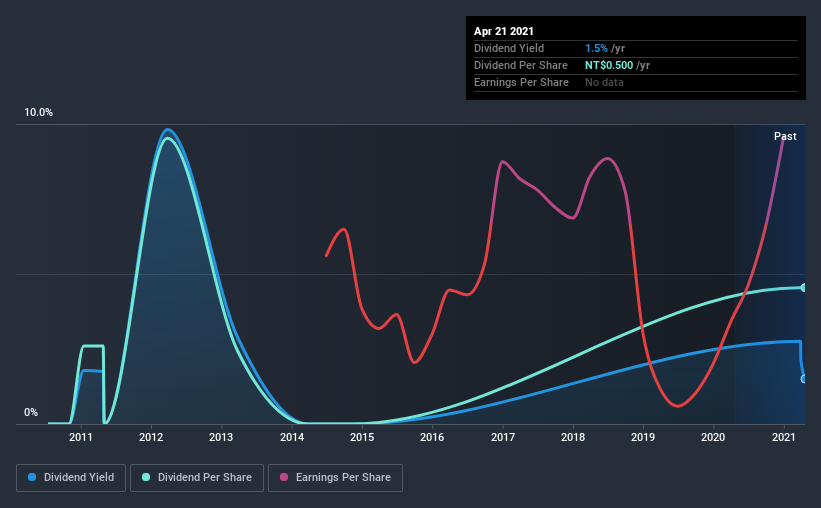- Taiwan
- /
- Metals and Mining
- /
- TWSE:2038
How Does Hai Kwang Enterprise Corporation (TPE:2038) Fare As A Dividend Stock?
Is Hai Kwang Enterprise Corporation (TPE:2038) a good dividend stock? How can we tell? Dividend paying companies with growing earnings can be highly rewarding in the long term. Unfortunately, it's common for investors to be enticed in by the seemingly attractive yield, and lose money when the company has to cut its dividend payments.
A 1.5% yield is nothing to get excited about, but investors probably think the long payment history suggests Hai Kwang Enterprise has some staying power. That said, the recent jump in the share price will make Hai Kwang Enterprise's dividend yield look smaller, even though the company prospects could be improving. Some simple analysis can offer a lot of insights when buying a company for its dividend, and we'll go through this below.
Explore this interactive chart for our latest analysis on Hai Kwang Enterprise!

Payout ratios
Dividends are typically paid from company earnings. If a company pays more in dividends than it earned, then the dividend might become unsustainable - hardly an ideal situation. As a result, we should always investigate whether a company can afford its dividend, measured as a percentage of a company's net income after tax. In the last year, Hai Kwang Enterprise paid out 57% of its profit as dividends. This is a healthy payout ratio, and while it does limit the amount of earnings that can be reinvested in the business, there is also some room to lift the payout ratio over time.
We update our data on Hai Kwang Enterprise every 24 hours, so you can always get our latest analysis of its financial health, here.
Dividend Volatility
From the perspective of an income investor who wants to earn dividends for many years, there is not much point buying a stock if its dividend is regularly cut or is not reliable. Hai Kwang Enterprise has been paying dividends for a long time, but for the purpose of this analysis, we only examine the past 10 years of payments. The dividend has been cut on at least one occasion historically. During the past 10-year period, the first annual payment was NT$0.3 in 2011, compared to NT$0.5 last year. This works out to be a compound annual growth rate (CAGR) of approximately 5.8% a year over that time. The growth in dividends has not been linear, but the CAGR is a decent approximation of the rate of change over this time frame.
It's good to see the dividend growing at a decent rate, but the dividend has been cut at least once in the past. Hai Kwang Enterprise might have put its house in order since then, but we remain cautious.
Dividend Growth Potential
With a relatively unstable dividend, it's even more important to see if earnings per share (EPS) are growing. Why take the risk of a dividend getting cut, unless there's a good chance of bigger dividends in future? Hai Kwang Enterprise's EPS have fallen by approximately 12% per year during the past five years. With this kind of significant decline, we always wonder what has changed in the business. Dividends are about stability, and Hai Kwang Enterprise's earnings per share, which support the dividend, have been anything but stable.
Conclusion
To summarise, shareholders should always check that Hai Kwang Enterprise's dividends are affordable, that its dividend payments are relatively stable, and that it has decent prospects for growing its earnings and dividend. First, we think Hai Kwang Enterprise has an acceptable payout ratio. Earnings per share have been falling, and the company has cut its dividend at least once in the past. From a dividend perspective, this is a cause for concern. Hai Kwang Enterprise might not be a bad business, but it doesn't show all of the characteristics we look for in a dividend stock.
Market movements attest to how highly valued a consistent dividend policy is compared to one which is more unpredictable. Meanwhile, despite the importance of dividend payments, they are not the only factors our readers should know when assessing a company. To that end, Hai Kwang Enterprise has 2 warning signs (and 1 which doesn't sit too well with us) we think you should know about.
If you are a dividend investor, you might also want to look at our curated list of dividend stocks yielding above 3%.
If you decide to trade Hai Kwang Enterprise, use the lowest-cost* platform that is rated #1 Overall by Barron’s, Interactive Brokers. Trade stocks, options, futures, forex, bonds and funds on 135 markets, all from a single integrated account. Promoted
Valuation is complex, but we're here to simplify it.
Discover if Hai Kwang Enterprise might be undervalued or overvalued with our detailed analysis, featuring fair value estimates, potential risks, dividends, insider trades, and its financial condition.
Access Free AnalysisThis article by Simply Wall St is general in nature. It does not constitute a recommendation to buy or sell any stock, and does not take account of your objectives, or your financial situation. We aim to bring you long-term focused analysis driven by fundamental data. Note that our analysis may not factor in the latest price-sensitive company announcements or qualitative material. Simply Wall St has no position in any stocks mentioned.
*Interactive Brokers Rated Lowest Cost Broker by StockBrokers.com Annual Online Review 2020
Have feedback on this article? Concerned about the content? Get in touch with us directly. Alternatively, email editorial-team (at) simplywallst.com.
About TWSE:2038
Hai Kwang Enterprise
Engages in the manufacturing and sales of billets and reinforcing steel bars in Taiwan.
Low risk with imperfect balance sheet.
Similar Companies
Market Insights
Community Narratives



